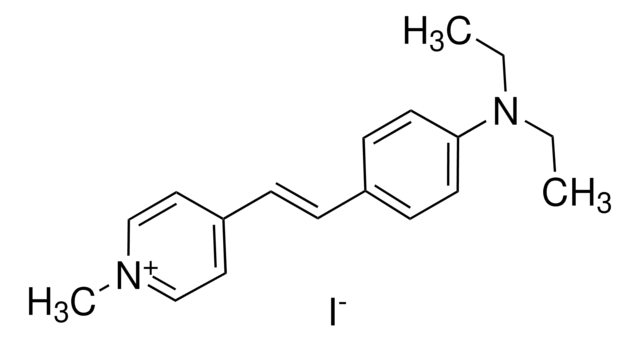This product may be stored at room temperature.
Wichtige Dokumente
83702
Rhodamin 123
BioReagent, for fluorescence, ≥85% (HPLC)
Synonym(e):
2-(6-Amino-3-imino-3H-xanthen-9-yl)-benzoesäure-methylester
About This Item
Empfohlene Produkte
Qualität
for fluorescence
Produktlinie
BioReagent
Assay
≥85% (HPLC)
Form
powder
Verunreinigungen
≤10% water
Löslichkeit
ethanol: 20 mg/mL, clear, red
Eignung
in accordance for fluorescence
suitable for fluorescence
SMILES String
Cl[H].COC(=O)c1ccccc1C2=C3C=CC(=N)C=C3Oc4cc(N)ccc24
InChI
1S/C21H16N2O3.ClH/c1-25-21(24)15-5-3-2-4-14(15)20-16-8-6-12(22)10-18(16)26-19-11-13(23)7-9-17(19)20;/h2-11,22H,23H2,1H3;1H
InChIKey
MYFATKRONKHHQL-UHFFFAOYSA-N
Suchen Sie nach ähnlichen Produkten? Aufrufen Leitfaden zum Produktvergleich
Verwandte Kategorien
Allgemeine Beschreibung
Anwendung
- as a substrate for P-glycoprotein (P-gp) to read out functional transporter activity in fluorescent accumulation assays[2]
- to label the cells for estimating the P-gp expression by flow cytometry[1]
- in transport studies, was added to the apical to basolateral (AB-transport) or basolateral to apical (BA-transport)[3]
- the detection of mitochondrial membrane potential (ΔΨm)[4]
Biochem./physiol. Wirkung
Sonstige Hinweise
Lagerklassenschlüssel
11 - Combustible Solids
WGK
WGK 3
Flammpunkt (°F)
Not applicable
Flammpunkt (°C)
Not applicable
Persönliche Schutzausrüstung
Eyeshields, Gloves, type N95 (US)
Hier finden Sie alle aktuellen Versionen:
Besitzen Sie dieses Produkt bereits?
In der Dokumentenbibliothek finden Sie die Dokumentation zu den Produkten, die Sie kürzlich erworben haben.
Kunden haben sich ebenfalls angesehen
Artikel
Nitric oxide (NO) as a signal transporter in neurons, endothelial cells and in the immune system.
-
Which is the storage conditions recommend for this product?
1 answer-
Helpful?
-
-
What are the excitation and emission wavelengths for Rhodamine 123 (Product Nos. 83702 and R8004)?
1 answer-
Using ethanol as the solvent, the excitation maximum is 511 nm and the emission maximum is 534 nm. The recommended excitation and emission wavelengths in PBS are 488 and 515-575 nm, respectively.
Helpful?
-
-
Why would one select Rhodamine 123 (Product Nos. 83702 and R8004) instead of other rhodamine compounds?
1 answer-
Due to is comparatively low toxicity, Rhodamine 123 is the dye of choice for visualizing mitochondria or for cell viability measurements.
Helpful?
-
-
What is the solubility of Rhodamine 123, (Product Nos. 83702 and R8004)?
1 answer-
Rhodamine 123 is soluble in ethanol at 20 mg/mL, and has been reported soluble in ether, various fats and lipids, and has limited solubility in water (no concentration given).
Helpful?
-
-
What is the Department of Transportation shipping information for this product?
1 answer-
Transportation information can be found in Section 14 of the product's (M)SDS.To access the shipping information for this material, use the link on the product detail page for the product.
Helpful?
-
Active Filters
Unser Team von Wissenschaftlern verfügt über Erfahrung in allen Forschungsbereichen einschließlich Life Science, Materialwissenschaften, chemischer Synthese, Chromatographie, Analytik und vielen mehr..
Setzen Sie sich mit dem technischen Dienst in Verbindung.











